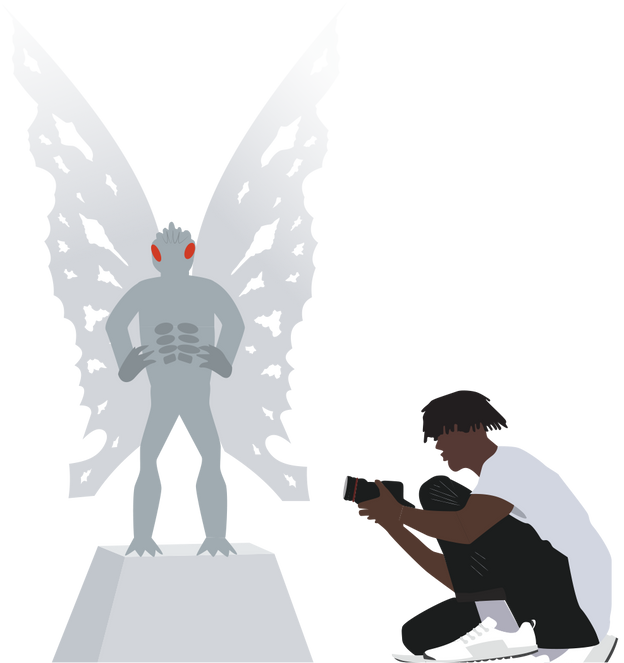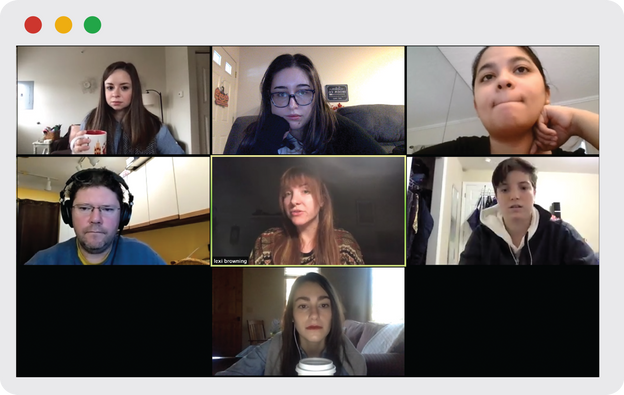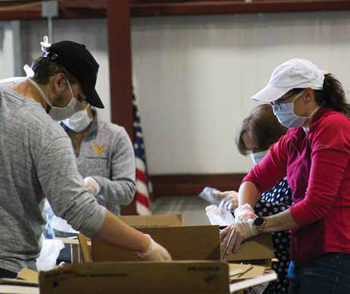Wanosky’s story for the special edition show combined her two very hands-on fields
of study that were now forced to operate without face-to-face interaction. She
interviewed dance instructors in her hometown of Parkersburg, West Virginia, who
were exploring ways to deliver lessons virtually and collaborated with Morgantown
Today classmates and the WVU News team to produce her story.
“It was a really supportive atmosphere,” said Wanowsky. “Everyone was so willing
to help one another because we were in it together. We wanted to produce the best
possible content that we could, and it was definitely something that I’ll never
forget.”
The special newscast won a College Coronavirus Coverage Award, sponsored by the Society
of Professional Journalists, Associated Collegiate Press, Society for News Design,
College Broadcasters, Inc., and The Foundation for Individual Rights in Education.
“I always think that if you raise the bar high with students, they just seem to meet
it,” said Dahlia.
Broadcasting students weren’t the only ones to change their reporting plans.
On the morning of March 12, Kayla Gagnon (BSJ, 2021) had just finished swimming in
the first round of the College Swimming & Diving Coaches Association of America
National Invitational Championship in Cleveland, Ohio. She and the rest of the
WVU Women’s Swimming and Diving team met in the lobby of their hotel to prepare
for the finals later that afternoon, when they were told to go back upstairs and
pack their belongings for departure.

“I prefer interviewing in person. There’s something different about sitting next
to a person and talking to them casually versus what we’re doing right now over
Zoom. But some of these performers – I would have never been able to see them or
meet them or watch them perform if this didn’t happen.”
KAYLA GAGNON, journalism senior
KaylaGagnon's (BSJ, 2021) dragumentary, "Introduction to the Queens of Quarantine."
“That’s when things started to feel real for me,” Gagnon said. “Things were getting
really serious. They cancelled the entire meet, we packed everything up, got on
a bus, headed back to Morgantown and I fled.”
Six days later, the University moved all classes online, including Gagnon’s photojournalism
course. Not only did this hands-on course become a virtual experience, but Gagnon’s
end-of-the- year video project centered on drag queens as they prepared for the
Miss Vice Versa Pageant, and that had just been cancelled.
“I was scrolling through Instagram when I was home over spring break ... and I noticed
a lot of the drag queens were posting that they needed financial support,” said
Gagnon. “They posted their Venmo’s and PayPal’s, saying that they needed a little
help because all of their gigs had been cancelled.”
Like everything else, the drag world was going digital and Gagnon saw an opportunity
to reach out to some of drag’s biggest celebrities to create a multimedia story
about how the community has been coping with COVID-19 — not only to salvage her
final project but also perhaps to help a lesser-known community in need.
One of those celebrities was Biqtch Puddin, the winning contestant on season two
of The Boulet Brothers' DRAGULA reality competition and one of drag’s most well-known
names.
“I reached out to Puddin and she got back to me within a day,” said Gagnon. “And
I just kind of threw myself into a documentary project before even talking to Professor
Raimondo [about the change].”
Gagnon ended up talking to drag queens and kings from cities all over the country,
including Los Angeles, Chicago, Pittsburgh, St. Louis, New York City and New Orleans
– all from her home in Kennerdell, Pennsylvania, where cell service is non-existent
and the only connection to the outside world is a small router in the corner of
the kitchen.
“I prefer interviewing in person. There’s something different about sitting next
to a person and talking to them casually versus what we’re doing right now over
Zoom,” she said. “But some of these performers — I would have never been able to
see them or meet them or watch them perform if this didn’t happen.”
The drag community, which typically relies on club shows and live events, was embarking
on new territory and Gagnon was there to shine a light on it and draw more attention
to these virtual events, which are the livelihood for this community for the foreseeable
future.

Hannah Belt, second from right, started her spring 2020 semester in the Czech Republic,
with other exchange students from countries includingFrance, Germany andCanada.
One-by-one, they were called home when Coronavirus took hold in Europe. Photo provided
by Belt.
Still Serving the State
Hannah Belt (BSJ, 2021), a public relations major from Thurmont, Maryland, was
only a few weeks into her study abroad program in Prague, Czech Republic, when
the United States banned travel from Europe. Italy and other European countries
began shutting down borders, and Belt was watching as her friends struggled to
find travel back to their home countries. When she woke up one morning to an email
from WVU explaining that she was required to come home, Belt also began the process
of booking an earlier-than-anticipated flight home.
“It was so heartbreaking, but I also had a sense of relief because I knew it was
just going to get worse,” said Belt. “I didn’t want to be away from my family when
that was happening.”
Belt returned to her hometown in Frederick County, Maryland, and began the mandatory
14 days of isolation, while continuing courses online through Metropolitan University
Prague.
“It’s tough. There’s a language barrier that's easier to understand in person,” Belt
said. “Through email, it’s a lot different.”
Shortly after her return to the states, Geah Pressgrove, associate professor and
advertising and public relations chair, contacted Belt with an opportunity. Pressgrove,
whose area of interest includes advocacy and nonprofit communications, initially
hired Belt as a research apprentice during her freshman year. Through this role
and a subsequent intern- ship with Your Community Foundation (YCF), Belt discovered
a passion for nonprofit and corporate social responsibility work.
YCF serves North Central West Virginia by investing donated funds to increase value
and distributing net earnings to deserving recipients as specified by the donors.
YCF was partnering with Philanthropy West Virginia, an organization that supports
nonprofits across the state, to raise funds for COVID relief during a special global
“Giving Tuesday” initiative, and they reached out to Pressgrove for potential interns.
Belt was first to come to mind.
“Hannah is incredibly talented and dedicated and is able to manage a project with
very little direction,” Pressgrove said. “I knew it be a perfect fit – both for
her and for Philanthropy WV.”
Belt created digital assets and a tool kit to benefit 53 relief funds as part of
a “Take 5 to Give $5” campaign. The initiative, which was co-sponsored by Toyota,
United Bank, West Virginia American Water and an anonymous donor, raised more than
$500,000 for COVID-19 relief in the state.
“I’m from Maryland, but I have so much pride in this campaign and the sense of community
in this state,” said Belt. “West Virginians are so passionate, and there are so
many nonprofits. I am just always amazed by how kind people are and how much they
give back.”
In August, Belt began working with the College’s Public Interest Communications (PIC)
Research Laboratory on a grant-funded project to explore COVID-19 virus-related
communication strategies to enhance community resilience. Through participatory
action research, which unites researchers and communities to create positive social
change together, she is working with a team of investigators led by Pressgrove
and Assistant Professor Julia Fraustino to engage community members in Monongalia
and Taylor counties. They will use a whole-community approach to identify co-created
solutions for issues of public health, equity and disaster resilience.
Like Belt’s work, many College of Media projects on both the journalism and advertising
and public relations sides are centered around West Virginia. And in a state
with one of the highest median ages and poverty rates, the impact of COVID-19 can
be quite threatening. When the state began to shut down in March, College of Media
students and faculty worked hard to continue providing essential news and services
to communities across the state and Appalachia.
BrandJRNY, the College’s community branding initiative, requires students to embed
themselves in West Virginia communities, to build personal relationships with residents,
develop trust and do extensive research that informs a custom branding plan.
“We really focus on the relationship building and we focus on the people and the
sense of place rather than just cranking out a bunch of deliverables,” said Rita
Colistra, associate professor and founder and director of BrandJRNY. “You can't
brand a place if you don't spend any time there experiencing it and really getting
to know the people. And, the people in the town really get to know us.”
On March 3, the BrandJRNY team of students led by Colistra and David Smith, teaching
assistant professor and BrandJRNY storytelling lead, launched the brand for Point
Pleasant, West Virginia, in front of a crowd of more than 170 residents. The Point
Pleasant website launched that same day, and then the students met in person for
the last time on March 12.

The latter part of the spring semester is spent implementing the brand – working
with local vendors to install billboards and signage, getting materials into the
hands of community business owners and preparing town leadership to carry out the
brand once the project is over. That work, which is typically done in person, was
moved to Zoom meetings, conference calls and texting, but the transition was made
smoother by the fact that the class was set up like an agency with those tools
already in place.
“We went from the high of just launching the brand to no longer seeing each other
in person,” Colistra said. “But I give credit to my students – they hung in there.
We were on a mission to continue this for our community. It’s about more than a
grade. We had just gotten the community so excited by launching this brand and
we didn’t want to stop everything.”

Uppercue, top center, participates in the weekly 100 Days editorial meeting via Zoom.
On the brand storytelling side, Smith’s students had already captured a lot of the
photographs and video footage for multi-platform storytelling that would accompany
the brand, so the workflow didn’t experience much interruption. The students worked
from their hometowns, communicating with Smith through a variety of online discussion
and file sharing platforms to complete video advertisements, audio storytelling
pieces and some augmented and virtual reality components for Point Pleasant.
“If everything had happened three or six weeks earlier, it would have been a lot
more difficult because we would have needed to go down to Point Pleasant,” Smith
said. “But for the students to be able to meet with the community, get their feedback
a little bit more and say some farewells would have been really nice.”
Just as BrandJRNY persisted in its mission to revitalize West Virginia communities
amid the pandemic, so too did 100 Days in Appalachia.

A nonprofit news partnership with West Virginia Public Broadcasting and the Daily
Yonder of the Center for Rural Strategies, 100 Days was created in 2016 to combat
Appalachian stereotypes and has been amplifying the region’s diverse voices ever
since. The news outlet collaborates with writers, reporters and visual journalists
throughout Appalachia’s 13 states to showcase the diversity of the region. During
the pandemic, many of these journalists were joining the ranks of the unemployed.
“We’ve seen dozens of papers in the region and across the country furlough and lay
off their journalists,” said Ashton Marra, digital managing editor of 100 Days
and a teaching assistant professor in the College of Media. “As we watched that
happen, we tried to respond by hiring some of those journalists and photographers.
The Charleston Gazette-Mail let go of a photographer that within two weeks I had
a project for. We’ve made it a goal to support the people that live in Appalachia.”
Since 100 Days has always been a digital news platform that works primarily with
freelancers, production has remained consistent. The big difference is that Marra
is no longer working out of the Media Innovation Center, where she held daily meetings
with Kristen Uppercue, editorial assistant for 100 Days. Uppercue (BSJ, 2019) will
graduate with her master’s degree in journalism in May 2021, and she’s been working
for 100 Days since her junior year – fall 2018.
“I miss meeting at the Innovation Center,” Uppercue said. “If I wanted to take a
break, if I needed to take a breath, I could just walk out and see a dozen different
people. But working from home, with the pandemic and protests and everything going
on in the news, it’s hard to take a step back and not feel like I’m falling down.”
Uppercue is typically behind the scenes – editing content, publishing stories on
the website and creating posts for social media. While she conducts interviews
and writes an occasional story, she is rarely out in the field. But at the onset
of COVID-19 in Morgantown, Uppercue was called upon to photograph local families
and volunteers with Feed Mon Kids, a program that has provided food to children
who stopped receiving school breakfast and lunch when the town went on lock-down.
Her work was published alongside photos by Brian Furguson in "The Front Porch Network
is a Lifeline in Appalachia," written by 100 Days freelancer Alison Stine. The
story was produced in partnership with Yes! Magazine and West Virginia Public Broadcasting
and explores ways community members are becoming more connected because of the
pandemic. Since that story ran in May, 100 Days has published more than 200 stories
that shed light on how the pandemic has affected people in Appalachia.
Although the fall 2020 term also has brought curricular challenges and changes, College
of Media faculty, students and staff have had time to reflect on spring to better
prepare for fall—whether that work be online, in person or a combination of
the two. Through it all, resiliency, patience and grace have been key.
“I am so proud of and grateful for our faculty and staff, who remain dedicated to
serving our students to the best of their ability under trying professional and
personal circumstances,” said Dean Diana Martinelli. “We’re in a unique position
to model flexibility, resiliency, empathy and professionalism for our students
during a time of international crisis, and I believe what we’re learning will ultimately
make us better and more creative teachers, mentors and colleagues.”